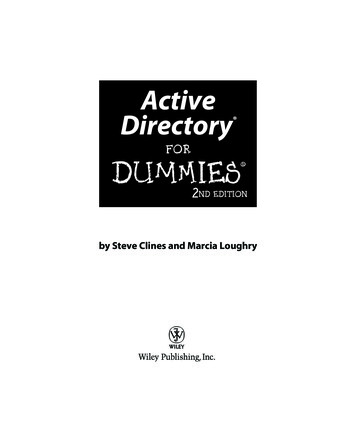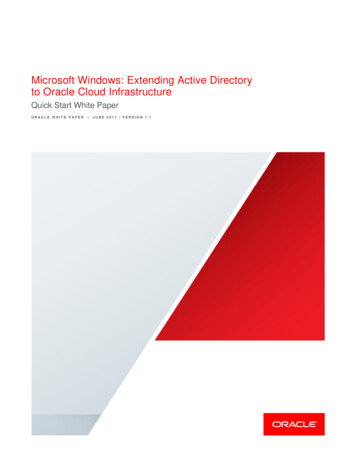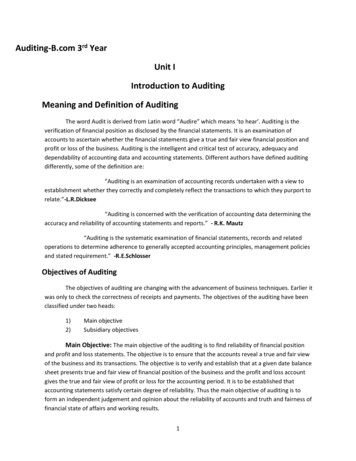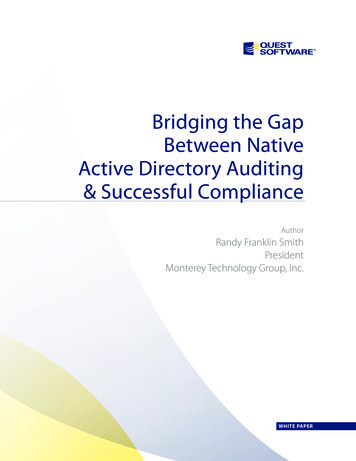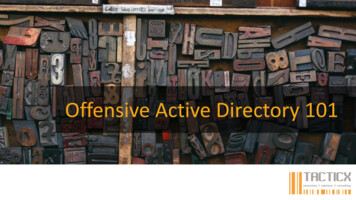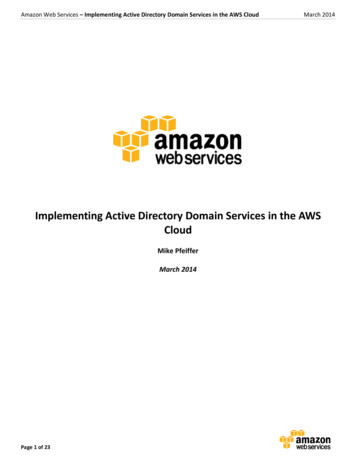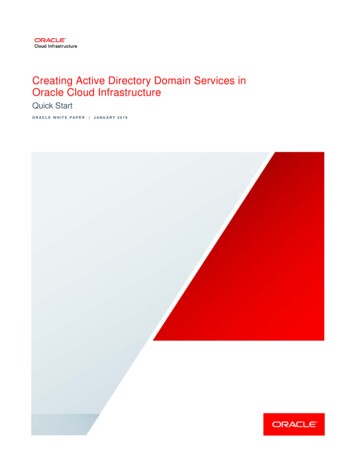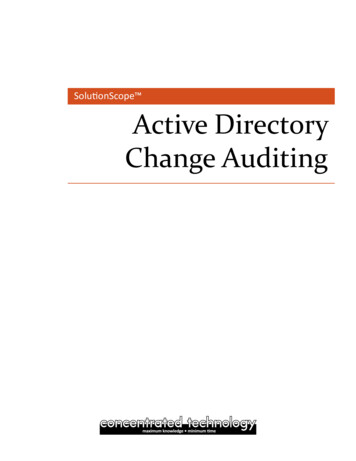
Transcription
SolutionScope Active DirectoryChange Auditing
Active Directory Change AuditingSolutionScope Executive OverviewChange auditing has become an important activity in business networks using MicrosoftActive Directory. In general, Active Directory’s native auditing features are insufficient toadequately support business needs such as troubleshooting, compliance enforcement, security auditing, and change management. These inadequacies in Windows’ native auditingare evidenced by the robust third-party market that has grown to fill this functional gap.The products and services of that third-party market offer customers a variety of choicesand approaches.For this analysis, Concentrated Technology surveyed 1,214 Active Directory administratorsand front-line IT managers. We interviewed 18 survey respondents for follow-up questions.We also interviewed four Independent Software Vendors (ISVs) who currently offer products in this space, comparing their products’ feature sets to the capabilities required by oursurvey respondents and interviewees. Finally, a small focus group was introduced to eachof the products and asked for their feedback.We reviewed shipping versions of all products as of January 2011. All data and statementsin this analysis are believed to be accurate as of January 2011.ContentsExecutive Overview—2The Auditing Features Companies Need—3Architectural Notes for Third-Party Solutions—5Business Concerns Around ISVs—6Blackbird Group, Blackbird Management Suite—7NetWrix, Active Directory Change Reporter—9Quest Software, ChangeAuditor for Active Directory and ChangeAuditor for LDAP—11ScriptLogic, Active Administrator—13Conclusion—152
Active Directory Change AuditingSolutionScope The Auditing Features Companies NeedRespondents to our survey identified an almost uniform set of features they felt were missingin the native Windows and Active Directory auditing architecture. Many of these featureshave been driven, in recent years, by the need for organizations to comply with externalindustry and legislative requirements. In the US, for example, legislation such as HIPAA,Sarbanes-Oxley, GLB, and so on were commonly cited, along with industry requirementssuch as PCI DSS. The commonly-requested features are as follows.Centralized, Secure Audit TrailWindows’ native auditing is neither centralized nor particularly secure, since administratorscan clear the log at any time. Recent versions of Windows Server now include the ability toforward events to a centralized event log; however, the event forwarding system works on aless-than-realtime basis, and does not adequately fulfill the requirement of a tamperproofor tamper-evident event repository. The native forwarding forwards events to a standardevent log, rather than a true database, which means the consolidated log still has many ofthe other weaknesses of the native log system, which we discuss next.Searching, Filtering, and ReportingWindows has no built-in reporting mechanism in its event logs, and provides fairly basicfiltering and searching capabilities. Because the native event logs aren’t stored in a relationaldatabase, extensive searching can also be time-consuming. Reporting was particularly citedas a weakness, since constructing the reports needed by security auditors is a time-consuming, almost entirely-manual task. Robust reporting is an absolute necessity, including theability to automatically generate and deliver reports on a subscription basis.Event TranslationWindows’ native events tend to include detailed technical data which is not always meaningful to an auditor or IT administrator. Many of our respondents indicated a need formore meaningful, “plain-English” events. Events that include “before and after” information about changes was also a request; while this has been partially provided in WindowsServer 2008 and later for many Active Directory events, more complete coverage of thisfeature is desired.AlertingWindows includes features for automatically generating alerts and notifications for specified events, such as changes to critical groups or sensitive directory objects. This kind ofalerting was identified as a requirement by most respondents. A weakness in Windows’native alerting capabilities, however, is the dependence on specific event characteristics. Forexample, defining an alert for changes to a specific Active Directory group is fairly complicated given the alert criteria that must be specified. Alerts are also not centralized (sincethe logs themselves aren’t), which is a significant weakness: In order to effective monitorchanges to a group (for example), that alert must be configured on every domain controller inthe environment.Backup, Recovery, and RollbackWhile not specifically tied to change auditing, the ability to undo or roll back unwantedchanges was cited as a highly-desirable feature by respondents. Rollback features imply3
Active Directory Change AuditingSolutionScope backup and recovery capabilities. Windows includes basic native backup and recoveryfeatures, and Windows Server 2008 R2 introduces an optional Active Directory Recycle Binfeature. However, these features are primarily designed at restoring single objects or groupsof objects. They are not intended for use in undoing attribute-level object changes.ArchivalWindows provides poor native capabilities for long-term archival of event logs, althoughmany organizations are now required (or desire) to maintain logs for up to 7 years. Windowssimply permits you to manually save the log files; scripting is required to automate thisprocess, but it doesn’t provide a true archiving solution.Separation of DutiesMost security and compliance policies mandate that auditing systems offer separation ofduties functionality. Auditors must be able to access the system in a read-only fashion, andadministrators who manage the auditing system must be prevented from tampering with theaudit trail. Windows does not provide this separation in its native event logging capabilities.Additional Systems to be AuditedActive Directory is not the only system that needs to be audited within organizations.While not within the scope of this analysis, respondents also indicated a need to auditother Microsoft-based systems, including Exchange Server, SharePoint Server, and SQLServer. Non-Microsoft file storage systems from EMC and NetApp were commonly citedas needing auditing. Where appropriate, we have noted vendors and solutions who offerauditing solutions that include, or that can be extended to include, auditing for these otherproducts and technologies.4
Active Directory Change AuditingSolutionScope Architectural Notes for Third-Party SolutionsThird-party change auditing solutions must typically make two key architectural decisions.Each of these decisions has both upsides and downsides.First, solutions must gather data from Active Directory. This can be done through an agentless system, or by using locally-installed agents on domain controllers. Agents provide betterinformation-gathering, performance, and often enable more robust features, but requiredeployment and ongoing maintenance. Agentless systems can create less overall impact onthe environment (although they do not necessarily offer better performance), but typicallyoffer less functionality. The solutions we evaluated for this analysis all offer an agent-basedapproach, although some also offer an agentless deployment option that includes reducedfunctionality.Second, solutions must decide where they will gather data. The main choices are toeither rely on the native event logs, to connect directly to Active Directory ApplicationProgramming Interfaces (APIs), or a combination of the two. The API approach oftenoffers better performance and an increased amount of information. If well-implemented, itcan also offer the option to disable native logging capabilities (which are not renowned fortheir high performance and low impact).5
Active Directory Change AuditingSolutionScope Business Concerns Around ISVsWhile many organizations are willing to consider third-party software tools to fill the gapleft by Windows’ native features, organizations are increasingly concerned about the stability and robustness of the ISVs they choose to deal with. Our respondents indicated a desireto work with ISVs that have a robust and responsive support organization. Manageriallevel respondents indicated an additional desire to work with vendors who show signs offinancial and organizational stability, suggesting that they will be able to weather economicdownturns and remain in business to continue supporting their products in the long-term.Product licensing is also a concern. In most cases, auditing solutions are licensed eitherper enabled directory account or per heartbeat; the latter model requires one license per humanbeing in the environment, without regard to the number of user accounts in the directory,meaning service accounts and other accounts not tied to a human being are not required tobe licensed.6
Active Directory Change AuditingSolutionScope Blackbird GroupBlackbird Management SuiteBlackbird Group has been in business since 2002, and has offered an Active Directory auditing solution since 2009. Approximately 500 customers have deployed the solution to date,with an average customer size of 3,000-5,000 users with the largest customer having morethan 5 million users. Blackbird Group employs approximately 30 people worldwide, andclaims to have a strong financial position with no significant debt. The company is privatelyheld.Blackbird Management Suite is an internally-developed suite of applications, includingBlackbird Auditor for Active Directory, Blackbird Recovery for Active Directory, BlackbirdProtector, and Blackbird Privilege Explorer. The products are licensed per heartbeat.Blackbird Management Suite relies on locally-installed agents connecting to native WindowsAPIs instead of the event logs, which is a common approach in this product category. Theproduct’s management console provides a means of centrally deploying or updating theagent, which helps to reduce the maintenance overhead often associated with the agentbased approach.Events are forwarded to a secured SQL Server database in near-realtime (also common inthis product category), providing a tamper-evident audit trail and the opportunity for separation of duties. Blackbird also supports database encryption.Archiving is accomplished through SQL Server database archiving. Because the productis fairly new, no customers are currently retaining more than a couple of years’ worth ofdata, so the efficacy of Blackbird’s archival approach remains to be seen over the long term.While SQL Server can absolutely be relied upon to manage enormous databases in themulti-terabyte range, conducting backup and restore operations of very large databases areoperationally challenging.Real-time alerts are provided through e-mail.The product provides full change rollback capability, and does so in a way that is betterintegrated and more intuitive than most products in this category. When viewing the changelog, a “rollback” button is available for each change listed. Overall, we feel that the product’srelative newness to the market gives it a “second comer advantage,” meaning the companyhas had the opportunity to look at existing products and design improvements to things likethe user interface. The rollback functionality is an excellent example of this, as it feels moreintegrated and accessible than is often seen elsewhere.Blackbird currently uses a proprietary reporting mechanism, but states that reporting willbe moved to SQL Server Reporting Services (SSRS) in the future, an increasingly-commonapproach and one we recommend. SSRS provides automated report generation and subscription delivery, as well as Web-based report delivery. Blackbird currently bundles 74 predefined reports and supports ad-hoc report creation. Reporting is integrated into the mainconsole, enabling report generation through right-click context menus on directory objects.Blackbird also currently supports scheduled report generation and delivery in PDF or XMLformats. Note: The Privilege Explorer component already utilizes SSRS for reporting; thiscomponent is focused on permissions management and was not reviewed for this analysis.Blackbird provides an MMC snap-in for management, but also integrates functionalityinto native Microsoft snap-ins, including Active Directory Users and Computers, GPMC,7
Active Directory Change AuditingSolutionScope ADSIEdit, and so forth.Blackbird Management Suite has had one major release and two minor releases in the pasteighteen months, with five patch releases that also included new functionality. This frequency suggests a product that is fairly stable and mature.Blackbird does not currently support direct integration with standard monitoring frameworks such as System Center Operations Manager, OpenView, Tivoli, etc. The companynotes that its email alerts can be used to funnel information into those systems, and theyare planning both SNMP support and Operations Manager management packs for futurereleases.The company offers similar auditing support for the Windows file system, and is in theprocess of developing components to cover SharePoint and Exchange.AnalysisWe believe the Blackbird Management Suite reflects a strong, clear vision for the marketsegment. Because of its relative newness in the market, the company has been able to createa product that has a modern user interface, which integrates tightly with native Windowsconsoles, and which offers deeply-integrated functionality across the product’s feature set.The Blackbird Management Suite product is competitive from an Active Directory perspective. It also has a good roadmap. The Management Suite’s various components lookand feel like a single, integrated product, rather than separate products that have specificintegration points. Cross-market analysis, however, suggests that its feature set lags behindthe competition in other areas, such as support for SQL Server, Exchange, SharePoint, andso on.8
Active Directory Change AuditingSolutionScope NetWrixActive Directory Change ReporterNetWrix has been in business since 2006, offering their first Active Directory change auditing solution in 2007. The product is in use by approximately 600 customers. An averagesized deployment is 1,000 to 2,000 directory users across 5-10 domain controllers in 2-3sites; the largest deployment is 60,000 users, 300 domain controllers, and 30 sites.NetWrix employs approximately 70 people and is privately-held. No financial informationis available, but the company appears to be stable and well-funded. Existing customers statethat they receive a good level of technical support when needed.Active Directory Change Reporter can be installed separately, but is also available as anintegrated part of a larger Change Reporter Suite. The complete Suite includes a ChangeReporter module for Exchange Server, Group Policy, Fie servers, SQL Server, VMware,System Center Virtual Machine Manager, SharePoint Server, Server Configuration, andNetwork Infrastructure. The products are all developed in-house, and are licensed perenabled Active Directory account.NetWrix offers both an agent-based and agentless infrastructure. Agents are recommendedfor distributed deployments of more than one AD site due to the agent’s ability to compressnetwork traffic. The product uses a combination of techniques to collect data, includingnative event logs as well as native APIs. This is an unusual approach in the market segment,which generally relies solely on native APIs and requires an agent-based deployment.The company states that the product scales up to 100,000 directory accounts and 500domain controllers. Information is forwarded in near-real-time to the SQL Server database.The product does not currently include functionality required to make the audit trail tamperproof or tamper-evident; however, the company does include that functionality in itsproduct roadmap. Separation of duties is provided, and individual reports can have customized permissions governing who can view the information contained in each.The company has a detailed strategy for ensuring that administrators cannot “fool” theaudit trail. We feel this strategy can make the existing database capable of being tamperevident, but only when proper SQL Server permissions are applied to the storage databaseand the long-term archival files. That strategy includes capturing all changes via DirSyncmonitoring, automatic restarting of their monitoring agent, among other techniques.NetWrix offers one of the most well thought-out long-term data archival strategies, using atwo-tiered system that utilizes SQL Server for online reporting, and file-based compressedstorage for long-term storage. The company states that the product can accommodate“years’ worth” of data.Real-time alerting is provided both via e-mail and SMS text messages.The product supports rollback of changes, down to individual attribute-level changes.Reporting is based on SQL Server Reporting Services (SSRS) with approximately 50 builtin reports and support for ad-hoc reporting. Scheduled report generation and delivery viae-mail are included for any pre-defined or custom report.NetWrix utilizes a proprietary MMC snap-in to manage the product, and utilizes the SSRSWeb interface for reporting.9
Active Directory Change AuditingSolutionScope In the past 18 months, NetWrix has issued one major release and seven minor updates tothe product. We feel that this falls within the realm of an operationally-stable product, andindicates active development and improvement of the product.NetWrix provides direct integration with System Center Operations Manager, but not withother non-Microsoft enterprise management frameworks.We feel that the NetWrix product provides a solid foundation of functionality. Through theother Change Reporter modules available in their Change Reporter Suite, NetWrix offerswhat is perhaps the broadest reach among those in the comparison, including network infrastructure, server configuration, and VMware vSphere, among other technologies.The ability to purchase only needed modules will be appreciated by companies, as they’renot required to pay for functionality they won’t use.Change Reporter’s functionality is straightforward, and the user interface is intuitive andeasy to operate. However, we feel some features could be better integrated. One exampleof this relates to the product’s change rollback functionality, which feels somewhat moredifficult to use with other products in this category. We don’t feel this difference is a majorproduct drawback, primarily because the UI still works well enough that administrators willquickly become familiar and comfortable with it.10
Active Directory Change AuditingSolutionScope Quest SoftwareChangeAuditor for Active Directory and ChangeAuditor for LDAPQuest Software was formed in 1987, and originally released ChangeAuditor in 2004.ChangeAuditor was originally released by NetPro Computing, which Quest acquired intoto in 2008. ChangeAuditor is used by approximately 2,000 customers, with an averageenvironment of 2,000 to 10,000 Active Directory users. The largest deployment is in a onemillion user environment. The product is license per enabled user.Quest employs approximately 3,400 people worldwide, and is a publicly-traded company(NASDAQ: QSFT). As such, more information is available about the company’s size,revenue, and financial stability than for privately-held companies: Quest has 493 million incash investments, an R&D budget that is approximately 18.5% of revenue, and more than100,000 customers worldwide – including 87% of the Fortune 500. The company maintainsmore than 60 offices in 23 countries, with 2010 revenue of 767 million.ChangeAuditor relies on an agent-based architecture to connect directly to native WindowsAPIs, and does
ScriptLogic, Active Administrator—13 Conclusion—15. Active Directory Change Auditing SolutionScope 3 The Auditing Features Companies Need Respondents to our survey identified an almost uniform set of features they felt were missing in the native Windows and Active
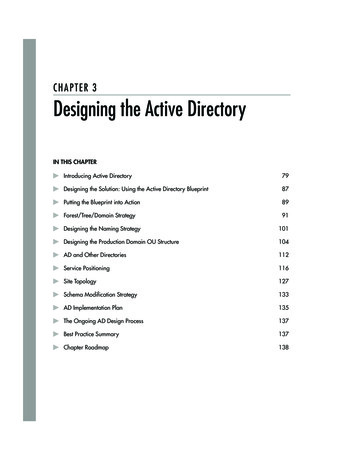
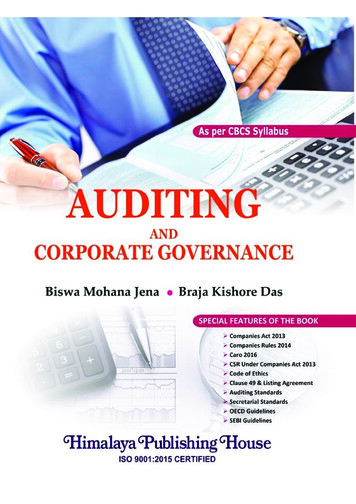
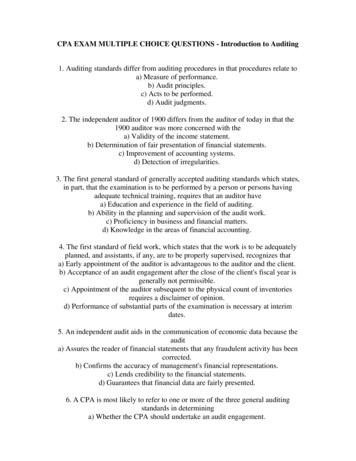
![[MS-ADFSOD]: Active Directory Federation Services (AD FS .](/img/1/5bms-adfsod-5d.jpg)
